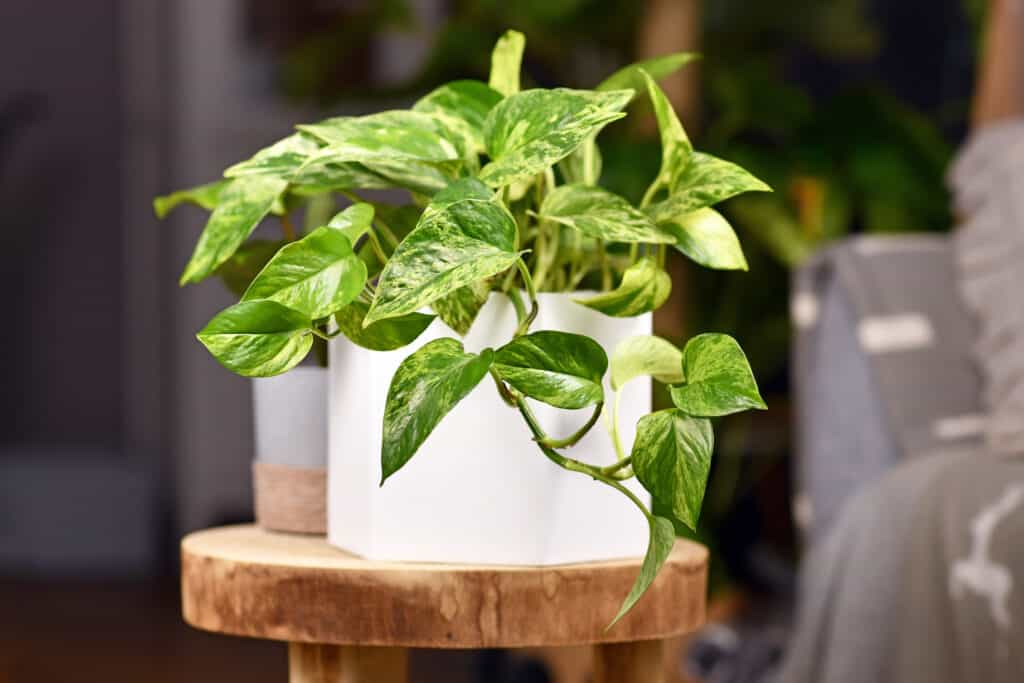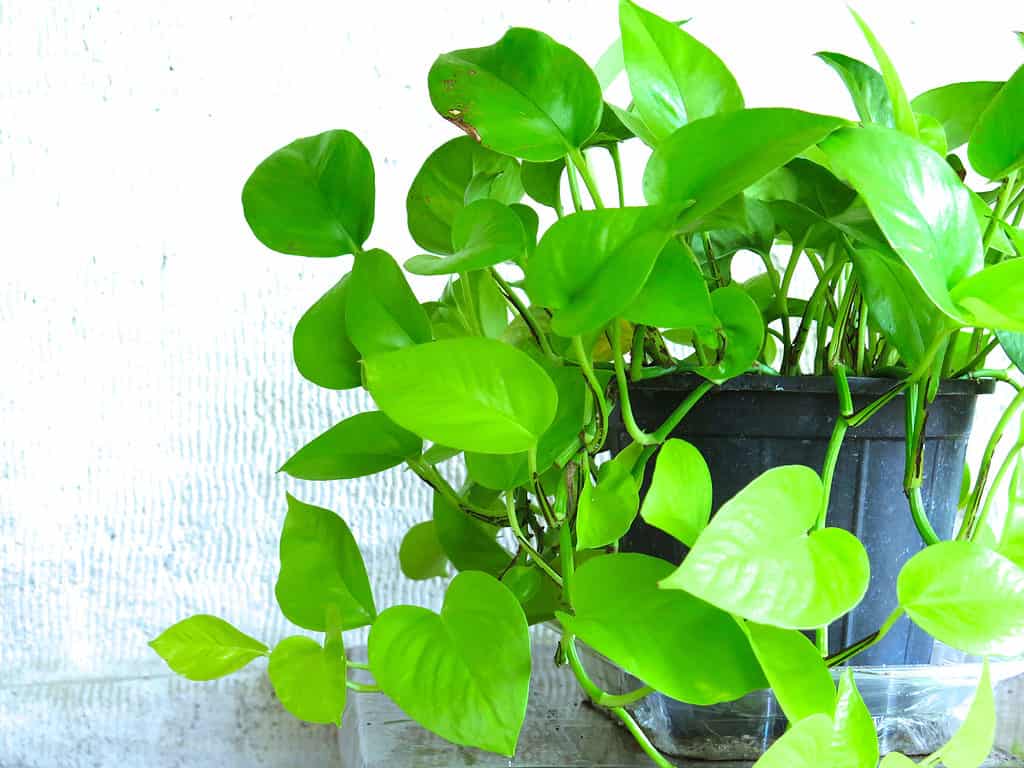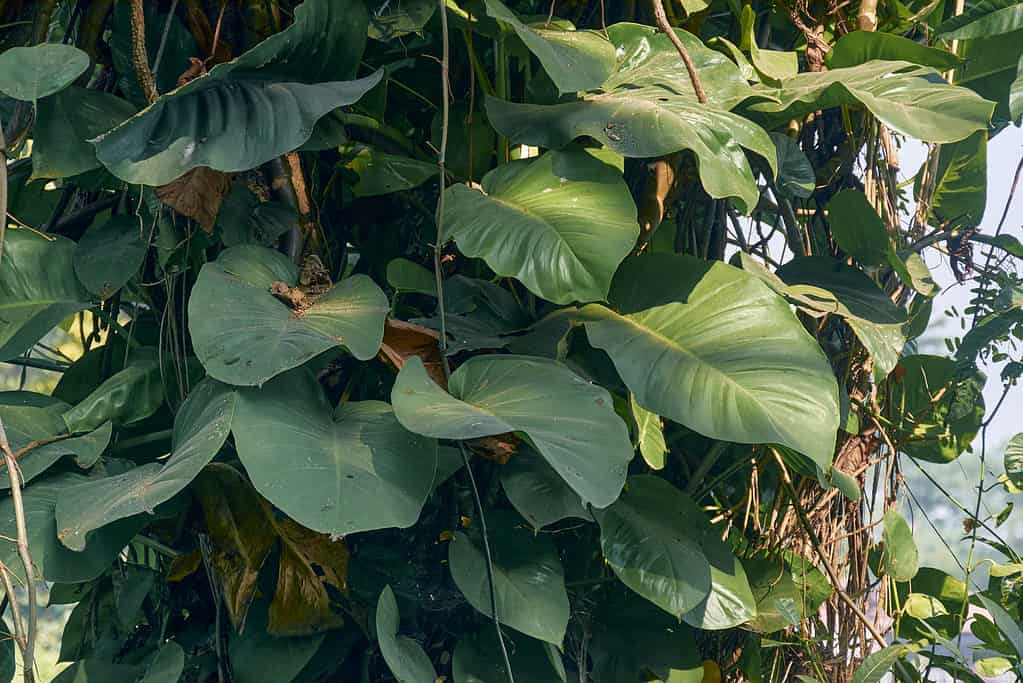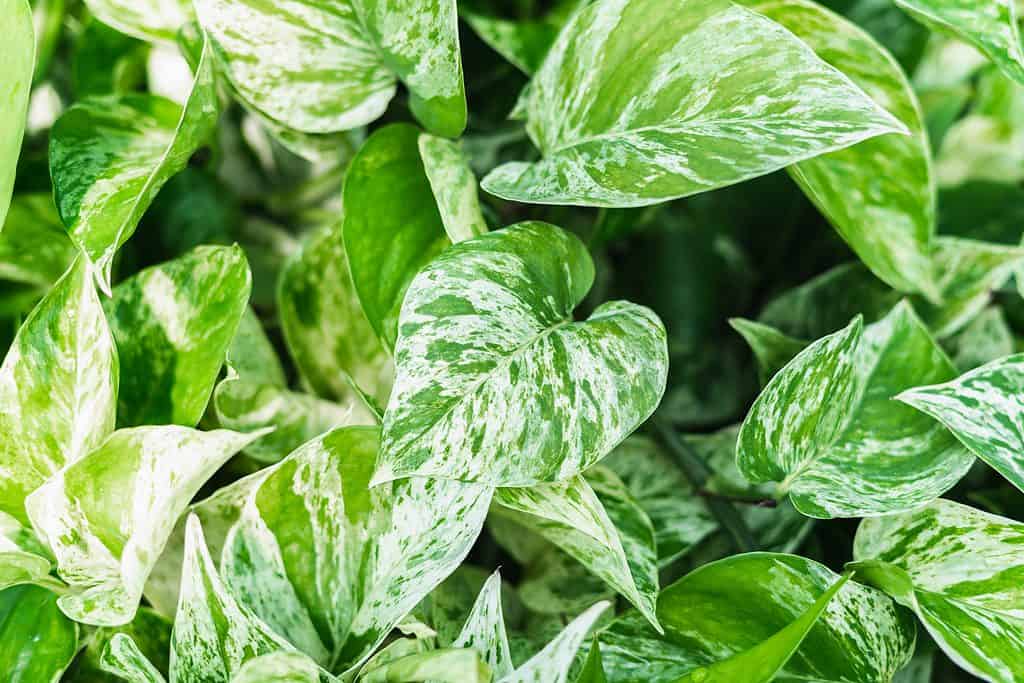Pothos plants have always been a popular low-maintenance houseplant. That’s because pothos plants are one of the easiest plant species to cultivate indoors and care for long-term. They feature shiney heart-shaped foliage that grow along tumbling stems and look stunning in stationary or hanging baskets as well as spilling over the edges of shelves and tables. They will also contentedly climb a trellis or pole when planted outside in the right conditions.
Interestingly enough, there is some misunderstanding as to which plants genuinely belong to the pothos group. Because of this, we’ve compiled a list of the top pothos varieties you can grow at home. Epipremnum aureum, a common and well-liked golden pothos, was originally classified botanically as Scindapsus aureus, which is why Scindapsus plants are frequently grouped with pothos plants.
No matter which variety of pothos you decide to go with, these plants can all survive in a variety of environments, including bathrooms, kitchens, and bedrooms. Bright light encourages rapid growth in these plants, although they may also thrive in medium or low-light conditions and under LED grow lights. The most crucial thing to keep in mind is that pothos plants don’t particularly like their roots being kept wet. So, wait until the top few inches of soil have dried out before watering them again. And if they start to get a bit out of control, prune them back as necessary. But keep the fragments you cut off, and new pothos plants can be propagated by cuttings. And who doesn’t want more pothos plants for free?
In this guide, we’ll explore some different types of pothos plants, so you can choose the right type of pothos plant for your needs.
The Classic Pothos Types
These four types of pothos plants are considered classic or original pothos plants, as they are all varieties that are found within nature and have the tell-tale pothos leaf shape.
Golden Pothos
Botanical Name: Epipremnum aureum
The golden pothos is without a doubt the most popular Epipremnum aureum variety, and possibly even the most popular houseplant out there. However, its commonness doesn’t make it any less beautiful. What’s not to love about this amazing golden yellow variety’s tremendous vining ability?
The pattern of the golden pothos’ variegation varies significantly from plant to plant and leaf to leaf. From leaves that are mostly dark green with just a hint of gold to leaves that are all gold, no two pothos plants will ever look the same. Your golden pothos’ leaves may even have the occasional white spot or variegation.

The Golden pothos (pictured) is a popular houseplant as well as an outdoor plant.
©iStock.com/Firn
Neon Pothos
Botanical Name: Epipremnum aureum ‘Neon’
This particular kind of pothos lives up to its name by displaying an almost artificially vivid neon green or yellow hue. It is undoubtedly the most brilliantly stunning pothos color you can find. It distinguishes itself from other popular indoor plants and offers some much-needed bright contrast against the typical sea of deep green.
To maintain this pothos type’s vivid chartreuse leaf color, you’ll need to keep the lighting as bright as you can while avoiding direct sunlight. With that exception, it’s equally simple to care for as the other pothos plants. If you’re feeling frisky, you can also find neon pothos with variegated leaves. Just keep in mind that these will be harder to find.

The leaves of the neon pothos (pictured) are much brighter than other cultivars.
©M.Sabouri/Shutterstock.com
Jade Pothos
Botanical Name: Epipremnum aureum ‘Jade’
Even if some of the flashy new cultivars can grab your attention, this old standby still reigns supreme as one of the best OG pothos varieties. The Jade pothos’ plainly green foliage is actually unique in the pothos world. No variegation at all: just clean, dark green foliage. If there is even the slightest variation, it does not qualify as a Jade variety.
Even though it is an authentic Epipremnum aureum, it is far more difficult to find in stores and online when compared to the more widely available variegated forms. Think of the extent plant collectors will go to in order to obtain a variegated monstera! Pothos plants are really a wild card in the world of houseplant collecting. It’s also worth noting that the only physical difference between the Jade and Golden pothos is their coloration.

If you don’t particularly care about variegation, the jade pothos (pictured) can be a really stunning addition to your plant collection.
©iStock.com/Suprabhat Dutta
Marble Queen Pothos
Botanical Name: Epipremnum aureum ‘Marble Queen’
One of the most well-liked varieties is the Marble Queen pothos and for certainly good reason. This cultivar has some mind-blowing speckled variegation. It is completely coated with wonderful white or cream tones, although it may also stray into gold or yellow tones. In other words, it occasionally resembles a highly variegated golden pothos, or could simply look entirely pale white and pale green.
On a Marble Queen pothos, the marble design is really marbly and has a ton of incredibly elaborate small specks and veins, making it quite easy to spot in a room full of other plants. Again, for this type to maintain its gorgeous creamy white hue, there must be enough bright indirect light to maintain its variegation.

The variegation of the Marble Queen pothos (pictured) is incredibly stunning and unique.
©DJD_Media/Shutterstock.com
Other Pothos Types
While the above classic pothos cultivars are lovely, there are additional pothos types worth knowing about, especially if you are a plant collector.
Manjula Pothos
Botanical Name: Epipremnum aureum ‘Manjula’
The Manjula pothos is a cultivar renowned for being one of the most variegated, with striking yellow and creamy white streaks and swirls on its huge, glossy green leaves. It is quite a bit harder to find than the common basic golden pothos.
The history of this variety of pothos has a bit of controversy. On one hand, there is evidence that it was developed by botanists at the University of Florida. However, Dr. Ashish Hansoti filed a patent for the plant, meaning it was likely developed in India. The latter is more likely the correct source of the Manjula pothos, as it is often confused with the UoF-developed Pearls and Jade pothos. “Manjula,” an Indian girl’s name that means “melodious”, is a fitting choice for this stunning plant. It’s important to keep in mind that these types of plants will want more sunlight with the more variation they have. Comparatively speaking to other pothos species, think of the Manjula and other variegated species as having serious sunlight needs compared to non-variegated cultivars.
Jessenia Pothos
Botanical Name: Epipremnum aureum ‘Jessenia’
The Jessenia is undoubtedly one of the most beautiful types on the market with its dark green and lime green marbled variegation, but it can be quite difficult to locate at nearby nurseries or even online.
The Jessenia pothos at first has a striking resemblance to the Marble Queen, but its vivid lime and green tones make it easy to tell them apart. It looks like the Marble Queen and the Neon pothos gave birth to a child that, fortunately, managed to retain both of its parents’ distinctive qualities. The leaf form and growth pattern of this variety should likewise be very similar to those of the classic four varieties. However, there have been some anecdotal reports that it might grow a bit more slowly than most pothos varieties.
Silver Satin Pothos
Botanical Name: Scindapsus pictus ‘Exotica’
The hue of the silver satin pothos is distinctive. This unusual variety features blue-green leaves with grey and silver specks, in contrast to the majority of other types’ brilliant green, yellow, and white hues. It also has less shiny leaves and boasts a more matte look.
Despite being popularly recognized as a variation of pothos, the silver satin pothos really does not share the scientific name Epipremnum aureum and is technically not even a pothos. The only significant difference between it and its closest relative, the satin pothos (also known as Scindapsus pictus ‘Argyraeus’), is the size and degree of variegation of its leaves. That being said, plants from Epipremnum and Scindapsus are often referred to as “pothos” collectively in the horticulture world.
Pearls and Jade Pothos
Botanical Name: Epipremnum aureum ‘Pearls and Jade’
The Pearls and Jade pothos, a mutation of the Marble Queen pothos variety created by the University of Florida, is particularly distinctive when compared to other cultivars. Compared to other pothos, it has smaller and more erratic-shaped leaves that grow to a maximum of three inches long and two inches wide. Its patterns are so faint and delicate that they are typically categorized as gray-toned. The Pearls and Jade pothos’ variegation consists of sporadic blotches, streaks, and speckles. It is not mottled like its parent Marble Queen pothos.
N’Joy Pothos
Botanical Name: Epipremnum aureum ‘N’Joy’
You might hate its name, but you won’t hate this lovely eye-catching pothos type. The popular cultivar known as the N’Joy pothos is deserving of a place on any shelf in any home or office. This lovely plant has distinctive green spots and atypically shaped leaves that vary greatly from one leaf to the next. This is not very common in pothos plants.
The N’Joy has short internodes, which means it has a more bushy growth habit than the Manjula pothos, albeit not nearly as pronouncedly. For this reason, it looks best with frequent trimming to keep it as a bushy plant rather than a climber. It will never be fully utilized as a trailing or climbing plant due to its specific bushy habit.
Global Green Pothos
Botanical Name: Epipremnum aureum ‘Global Green’
The Global Green pothos is a relatively new cultivar in the world of pothos plant-collecting, as it was only patented by Japanese breeder Hiroaki Asaoka in 2021. As such, it is a serious headache to locate in nurseries and online due to its rarity. However, in due time, this variety will likely become easier to find as it propagated and is bred into new plants.
This plant’s hues, which range from dazzling light green to dark emerald green and shades in between, are very comparable to those of the Jessenia pothos. The Global Green, however, resembles the N’Joy pothos in terms of its uneven leaf form and blotched variegation pattern. It has gorgeous wide and pointed leaves in a deep green color with scattered lighter green spots that are often concentrated in the center of the leaf. It also has a “crumpled” look to it that sets it apart from other varieties.
There are so many beautiful different types of pothos plants out there, and you have a ton of options when it comes to your personal aesthetics. Just keep in mind that while pothos plants are quite resilient and hardy, they do need a bit of attention in order to really thrives both outdoors and indoors.
Want to learn more about the eye-catching pothos houseplant? Check out our in-depth guide to everything you need to know about pothos!
The photo featured at the top of this post is © sharohyip/Shutterstock.com
FAQs (Frequently Asked Questions)
What are the most common types of pothos?
There are many common types of pothos varieties, a few including the general golden pothos, Marble Queen pothos, and satin pothos.
Are there any rare types of pothos?
Harlequin pothos, Manjula pothos, and neon pothos are a few rare varieties that won’t be easily found at a nursery.
Are variegated pothos rare?
Variegated pothos are not extremely rare and can be found quite easily online or in nurseries.
Thank you for reading! Have some feedback for us? Contact the AZ Animals editorial team.






